This post contains Amazon Affiliate links. That means that if you make a purchase through a product link, I will earn a small percentage of the sale at no additional cost to you.
Several weeks ago on the Curious George PBS Kids show, I saw a fun idea to create musical compositions with a mathematical element. In the “real kids” segment of the show, a classroom teacher gave his students a xylophone with all but two keys removed. The two remaining keys were labeled “5” and “10.” The students were instructed to write a composition by creating a pattern of the two notes with the only requirement being that the finished composition needed to add up to 100.
I absolutely love this activity! For one thing, this is a great way to explore musical composition without overwhelming kids. Instead of trying to create a song out of an endless number of notes (too open-ended), kids have a manageable amount of notes to choose from and a goal in mind (add up to 100). The other thing I love about this is that by pre-selecting the notes, basically any composition will sound pleasant to the ear. So it’s a guaranteed success!
Kids are practicing SO many skills through this activity:
- Mental addition
- Counting by 5’s, 10’s
- Musical composition
- Reading left to right
- Remembering a sequence
- Hand-eye coordination
We adapted this activity for home instead of a classroom, and the boys loved it. (Ages 5, 7, and 10)
Use real instruments – or make your own!
We own several real kid’s instruments that I purchased for use in our homeschooling. I’m a violinist and love music and instruments, so it was worth the investment. If you don’t own any real instruments – keep reading! It would be easy to do this activity with homemade instruments.
At each station, we used color coded notes. I showed the boys how to write a composition by drawing music notes that matched the color of the note they wanted to use.
Adapt the Math Level:
I chose to aim this activity at Gresham’s math level (finished 2nd grade, starting 3rd grade in the fall), and so I used the numbers 5, 10, and 15. He and Aidan wrote songs that added up to 100 and 200. I had Owen (age 5) just draw the notes without worrying about the addition part of the activity. For younger kids, you could either use small numbers and write songs that add up to 5 or 10, or just skip the adding part. Writing the notes and reading back the sequence is a fantastic project for a kindergartner.
Gresham tried out my sample composition for the xylophone, and the boys were hooked. Seriously, this was a lot of fun. The boys wrote many compositions, and couldn’t wait to perform them for Dad when he came home from work!
Station 1: Xylophone
I chose the notes C, E, G, and C for our compositions and labeled them 5, 10, 15, and 5 (both the high and low C’s were 5’s). I didn’t want to use any numbers higher than 15 – a note with a value of 20 or higher would take up too much of a composition worth 100.
I can’t find a link for the xylophone we own, but this Hohner xylophone is similar. (Read on for ideas on how to do this activity if you don’t happen to own any “real” instruments!)
Station 2: Piano
Owen loved having a clip board for his compositions.
Station 3: Percussion
For the percussion station, we used three Remo kid’s drums, a woodpecker block, and a frog guiro. The woodpecker block makes a sharp, loud percussion sound. The bongo drums are more muted. So fun to explore different sounds!
Don’t have instruments? Make it yourself!
Different width rubber bands make a great shoebox guitar! Gresham found colored pencils to match the colors of his rubber bands so that he could write a song.
To add the math part – write numbers on the outside of the box next to each rubber band.
We shoved a craft stick into the bottom of the box to keep it from collapsing as much under the force of the rubber bands. It’s amazing how cool rubber bands sound – you actually do get different notes!
Other ideas for homemade instruments:
- Toilet paper roll shaker – fill with rice or beans and cover the ends with paper
- Paper plate shaker – staple two paper plates together and fill with rice or beans
- Oatmeal container drum
- Metal pot as a drum
- Glasses filled with different amounts of water – tap with a spoon
Note: This is definitely not “real” musical note reading. I showed the boys how to make their notes as quarter notes, but we did not have a way to record the rhythm of their song. They just played whatever rhythm they wanted it to be. Aidan knows how to read music on a staff, and Gresham is learning. This activity is not meant to be a replacement for note reading, but more of an introduction to composition and a fun way to combine music and math.

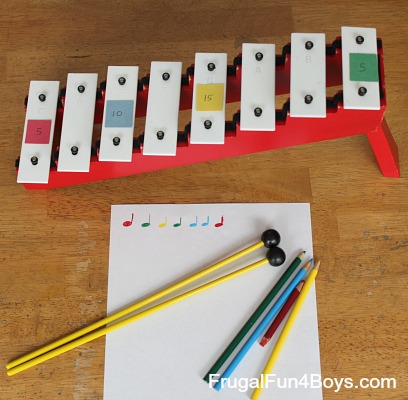
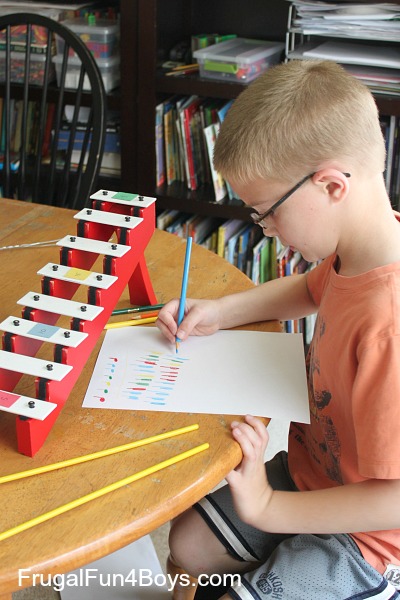

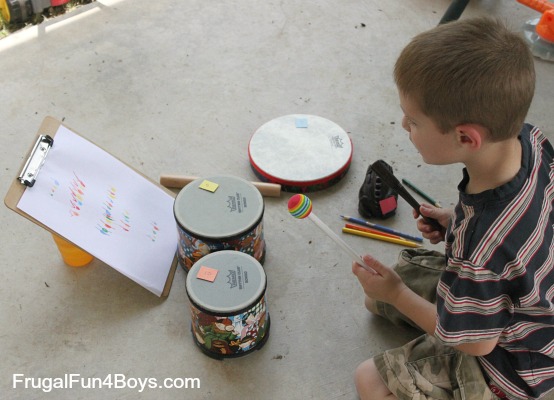
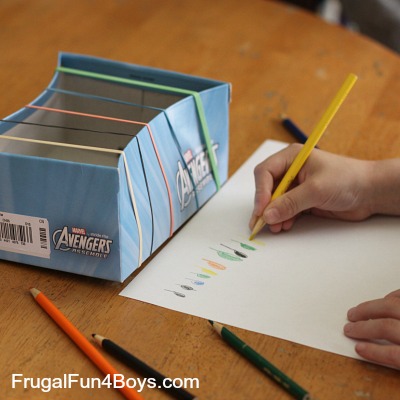
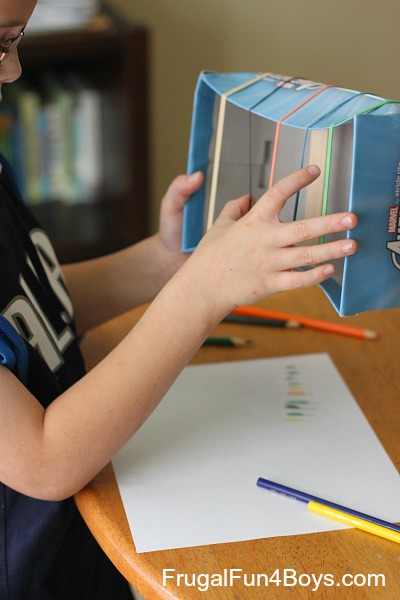
6 Comments
Almost Unschoolers Jul 15, 2014
I LOVE this - pinning for later :)
Jennifer Aug 12, 2014
I have an almost 6 year old. Is this an activity that would be beneficial or would we just confuse him mathematically?
dibts.com Dec 25, 2014
It's the best time to make some plans for the longer term and it's time
to be happy. I have learn this put up and if I may I wish to
recommend you some fascinating things or tips. Maybe you can write subsequent articles referring to this article.
I want to learn more issues about it!
Pat May 23, 2015
I am a 1st grade music teacher and we use the xylophone in your pictures. It is called "step bells" like this:
http://www.amazon.com/Basic-Beat-8-Note-Diatonic-Step/dp/B0002GVCCC/ref=sr_1_2?s=musical-instruments&ie=UTF8&qid=1432430048&sr=1-2&keywords=step+bells
My students love them. Your activity has great potential for connecting math and music.
Peggy Pelligra Jun 14, 2015
I am a first grade teacher and in the summer I love going through different sites that I have bookmarked or going to
pinterest. I find so many things I want to implement for the next year. It can be overwhelming. I loved your musical math! We have a story in our reading series called The Musical Day and the kids in the story make instruments like you have shown. My students always want to do this, but I don't have all of the supplies for allowing each student to make an instrument. However, since I know now about this, I could begin collecting various types of boxes, etc. I would really like to see a completed composition so I can understand the math part. Woudl you be able to show me one? Also, if we are making our own instruments, how do you assign musical letters? I am a bit confused about that. If someone make a guitar out of a shoebox and rubber bands, what would you choose as the 2 notes and where would you placr those numbers. I look forward to any kind of feedback you could give me, because my students would love this! Thanks, Peggy Pelligra
Sarah Jun 14, 2015
Peggy, It has been a while since we did this activity, so I don't have a completed composition to show. But here is how I would do it with a cardboard box guitar. For first graders, I would probably just put two rubber bands on the box. Make sure that they are two different colors, and two different thicknesses would be great as well. Name one of the rubber bands 1 and the other one 5. Then have them write a composition that adds up to 20? Or 50? Your numbers will probably depend on what point in the school year it is and what their number sense is like at that point.
So, for example, if you have two notes (red worth 1 and blue worth 5), they could write a composition adding to 20:
Blue Red Red Red Blue Red Red Blue
Or give the notes the values of 1 and 2 and write a composition adding to 10.
Hopefully that helps!
Peggy Pelligra Jun 24, 2015
Thank you Sarah, I think I get it now. My only question is after they get their notes made to
a certain number, do they try to play the notes on their instrument? It seems to make sense that way.
Sorry for the questions but I know the kids would love this.
Gloria Feb 26, 2019
I will try this during summer school. Great STEM activity.
Post a Comment